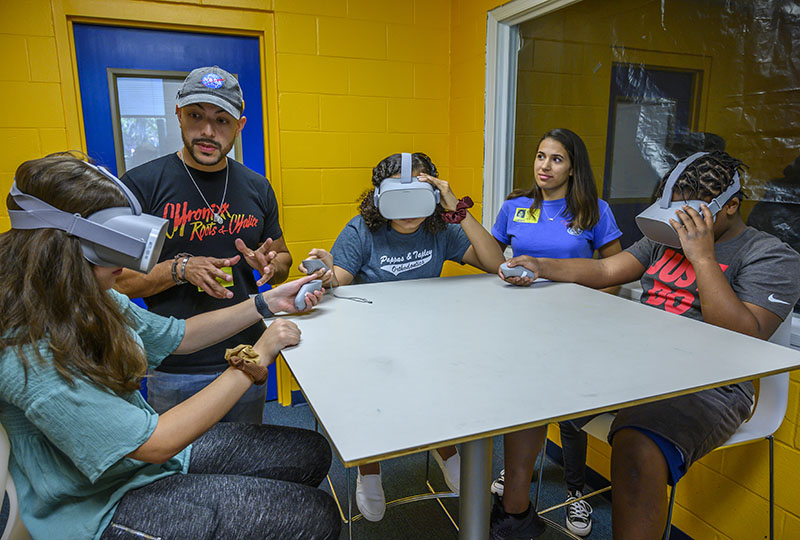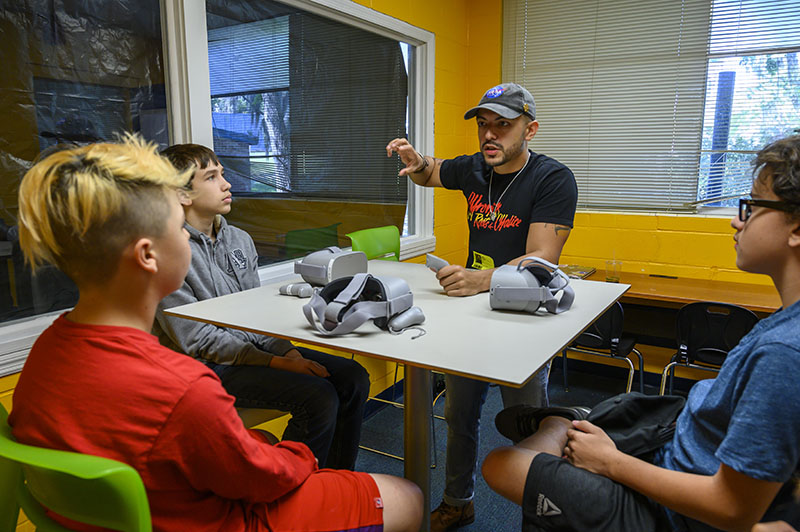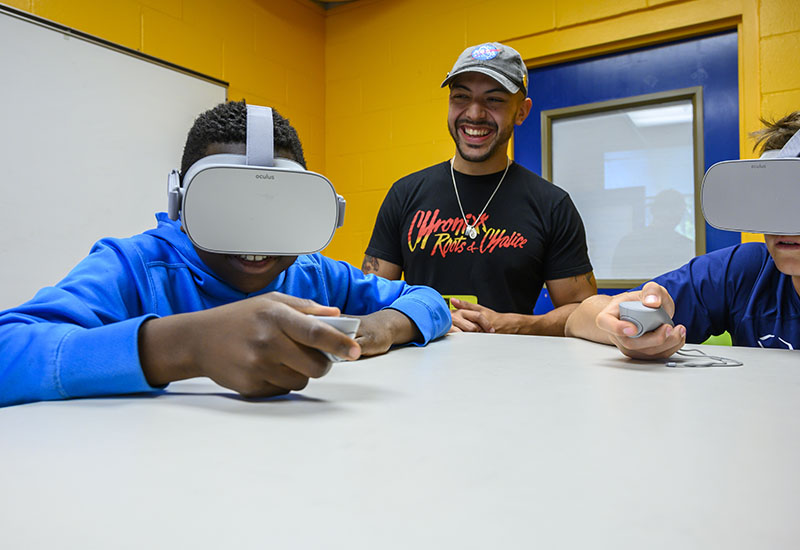This spring, 91 seventh graders in Mayra Cordero’s class at P.K. Yonge Developmental Research School in Gainesville boarded a Hercules C-130 airplane alongside paleoclimatologists and soared toward Antarctica to complete their expedition.
Their mission? To extract an ice core from a polar ice cap and inspect its geological markers for climate change indicators. But, they weren’t allowed to leave their classroom.
With funding from the UF Thompson Earth Systems Institute, Daniel Pimentel, a Ph.D. student in the UF College of Journalism and Communications, has developed a 10-minute virtual reality simulation titled, “Virtual Climate Scientist: A Polar Ice Cap Expedition.” The simulation was developed as a supplement to the traditional middle school weather and climate science curricula.

“Research shows that immersive storytelling platforms, like virtual reality, can help both students and adults understand social and environmental problems at a more visceral level,” Pimentel said.
“This interactive experience allows students to learn how scientists use ice cap information to make predictions of future climate change.”
To develop the simulation, Pimentel first interviewed several scientists, including TESI faculty fellow Andrea Dutton, to get a better idea of how to make the simulation as realistic as possible. From there, he drafted a storyboard and script and worked with voice actors to create the expedition’s paleoclimatologist characters.
Pimentel said when creating the simulation, he and his team were careful to make the experience inclusive so that students could really identify with their avatar. To do so, the gender of the avatar was masked with weatherproof clothing. The other scientists on board represented a wide range of genders, races and ethnicities.
“We’re really excited to see whether including that can have an influence on how they perceive themselves as future scientists and their interest in STEM overall,” Pimentel said.
Before bringing the pilot simulation to Cordero’s classroom, Pimentel first introduced students to the headsets and controls. He also gave the students a pre-test to gauge their initial knowledge of paleoclimatology and climate-related terminology.
A week later, they were ready to board the plane and be briefed on their expedition. Using the controller, they grabbed a hand ice auger, bored it into the compacted snow and extracted an ice core.
“It was fun, maybe too much fun, seeing students feel as though they were on an actual ice cap. The way they reacted to the scientists, their trip on a snowmobile, and the extraction of the ice was very realistic,” Pimentel said.
“Overall, they enjoyed the experience and felt it actually helped them learn about weather and related subject matter. As many of the students articulated, the ability to actually do instead of simply read was really helpful.”
Once the simulation was over, students returned to their desks to analyze climate data, collected by real-life climate scientists.
“By adding the lesson onto the virtual simulation, students learn how scientists are using data to arrive at certain conclusions about climate change and sea-level rise,” Pimentel said.
The students were then asked to complete a posttest and write a brief essay describing what they learned. A month after the initial simulation, Pimentel and his team conducted a focus group with about 10 randomly selected students.

Results were promising.
Pimentel said there was a significant increase among black and white students in how much they viewed themselves as future scientists. There was no significant increase in this category for students who identify as Asian/other and Hispanic, but Pimentel said this could be due to the small sample size of nine students.
“These results show how much the students identified with the virtual scientists,” Pimentel said. “This emphasizes how virtual scientists can have a positive effect on students’ learning experiences, and ultimately serve as realistic influences over how students view themselves.”
Pimentel also wanted to measure how students viewed different aspects of science. For example, on the pre and posttests, students were asked to rate their level of agreement with statements like, “Women are welcome in science just as much as men are,” and “Science can help save our natural environment and resources.”
“The results show that across all racial groups, students demonstrated a favorable shift in their views of science,” Pimentel said.
The virtual climate scientist expedition is part of a larger initiative led by the UF CJC Media Effects Lab.
“We have a vision here in this lab where we want to create and use immersive storytelling to create positive social change,” Pimentel said.
Every product coming out of the lab is tied to one of the United Nations 17 Sustainable Development Goals which include calls to action to end hunger and poverty, reduce inequality and inspire climate action.
“Virtual reality allows the user to assume the perspective of the ‘other,’ and it is through this perspective-taking that users may immersive themselves in scenarios that are otherwise out-of-reach, providing a safe and interactive learning experience,” Pimentel said.
Pimentel added that there is still work to be done on this simulation. His next goal is to better relate Antarctic climate science to Floridians. Version 2.0 will begin in the Florida Everglades, where users will learn about some of the climate-related issues facing coastal communities in Florida.
“From there the user will fly to Antarctica and see how scientists are using data there to arrive at certain conclusions about climate change and sea-level rise here in Florida,” Pimentel said.

With the first pilot simulation under his belt, Pimentel said he is excited to bring the project on the road to other schools and informal learning opportunities.
“All of the students enjoyed the experience, and were highly engaged, though one reaction still sticks with me.”
He recalls a black student beaming with excitement after removing his headset.
“He spent the next five minutes telling me about how he met a scientist on the trip, Dr. Washington, noting excitedly that he was a scientist who actually looked like him,” Pimentel said.
“It was very moving because as a Latinx I know how important it is to see people in leadership roles who you can identify with. To be able to witness that moment was very special. I’ll never forget it, and I hope other students can have a similar experience.”
To learn about all of the TESI grant recipients, visit: 2018 Earth Systems Grant Recipients